Engine type TOYOTA PRIUS C 2012 NHP10 / 1.G Owners Manual
[x] Cancel search | Manufacturer: TOYOTA, Model Year: 2012, Model line: PRIUS C, Model: TOYOTA PRIUS C 2012 NHP10 / 1.GPages: 552, PDF Size: 8.27 MB
Page 105 of 552
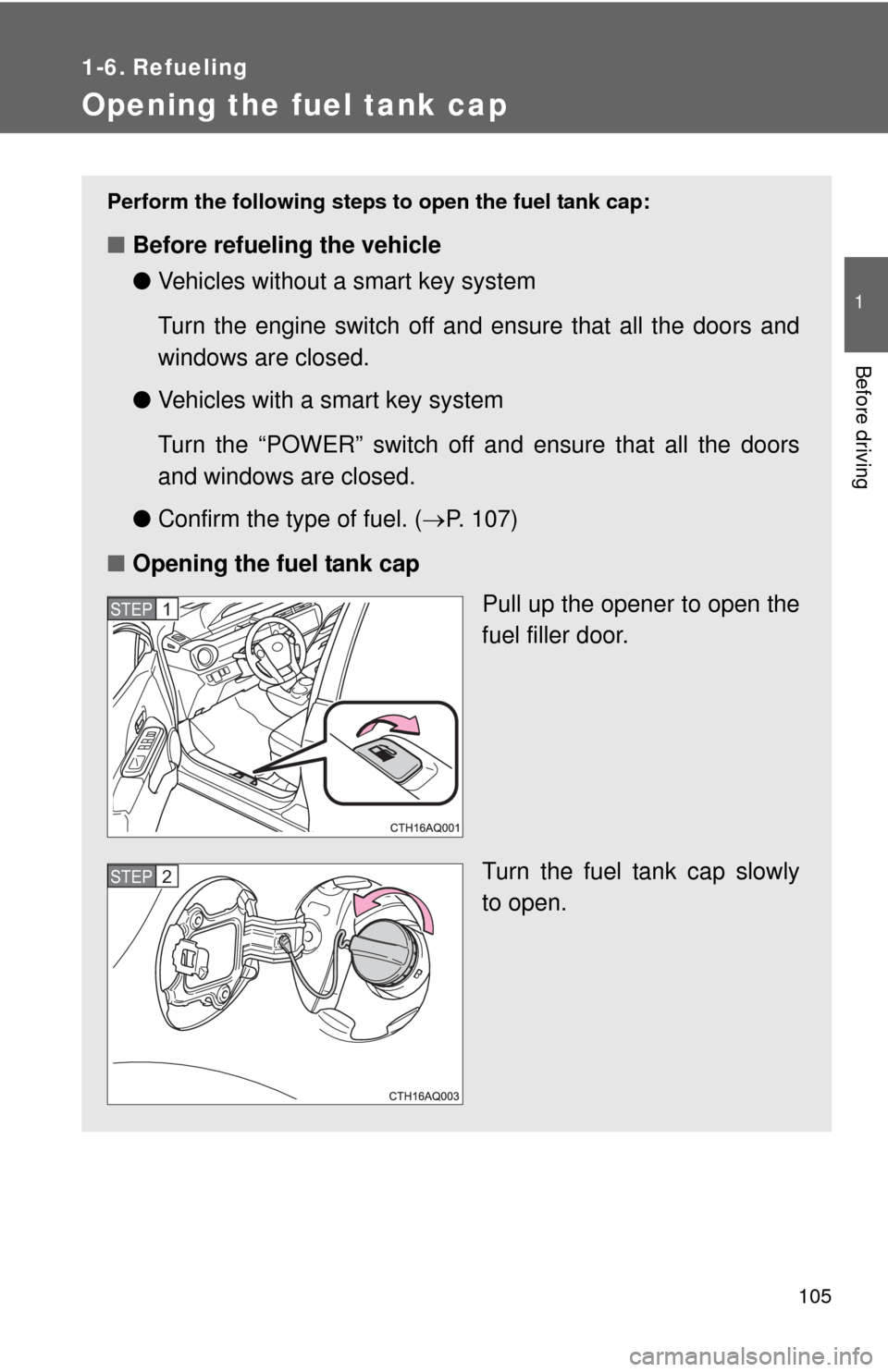
105
1
Before driving
1-6. Refueling
Opening the fuel tank cap
Perform the following steps to open the fuel tank cap:
■Before refueling the vehicle
●Vehicles without a smart key system
Turn the engine switch off and ensure that all the doors and
windows are closed.
● Vehicles with a smart key system
Turn the “POWER” switch off and ensure that all the doors
and windows are closed.
● Confirm the type of fuel. ( P. 107)
■ Opening the fuel tank cap
Pull up the opener to open the
fuel filler door.
Turn the fuel tank cap slowly
to open.
STEP1
STEP2
Page 107 of 552
![TOYOTA PRIUS C 2012 NHP10 / 1.G Owners Manual 107
1-6. Refueling
1
Before driving
■
Fuel types
Unleaded gasoline (Octane rating 87 [Research Octane Number 91] or
higher)
■ Use of ethanol blended gasoline in a gasoline engine
●Make sure that TOYOTA PRIUS C 2012 NHP10 / 1.G Owners Manual 107
1-6. Refueling
1
Before driving
■
Fuel types
Unleaded gasoline (Octane rating 87 [Research Octane Number 91] or
higher)
■ Use of ethanol blended gasoline in a gasoline engine
●Make sure that](/img/14/6621/w960_6621-106.png)
107
1-6. Refueling
1
Before driving
■
Fuel types
Unleaded gasoline (Octane rating 87 [Research Octane Number 91] or
higher)
■ Use of ethanol blended gasoline in a gasoline engine
●Make sure that the ethanol blended gasoline to be used has a suitable
Research Octane Number as outlined in “Fuel types”.
●Use only gasoline containing a maxi-
mum of 10% ethanol.
DO NOT use any flex-fuel or gasoline
that could contain more than 10% etha-
nol, including from any pump labeled
E15, E30, E50, E85 (which are only
some examples of fuel containing more
than 10% ethanol).DO NOT use gasoline
containing more than 10%
ethanol.
(15% ethanol)
(50% ethanol)
(85% ethanol)
Page 204 of 552

204 2-3. Operating the lights and wipers
■Daytime running light system
●To make your vehicle more visible to other drivers, the headlights turn on
automatically (at a reduced intensity) whenever the hybrid system is
started and the parking brake is released. Daytime running lights are not
designed for use at night.
For type A: Daytime running lights can be turned off by operating the
switch.
● Compared to turning on the headlights, the daytime running light system
offers greater durability and consumes less electricity, so it can help
improve fuel economy.
■ Light reminder buzzer
Vehicles without a smart key system
A buzzer sounds when the engine switch is turned to the “LOCK” or “ACC”
position and the driver's door is opened while the lights are turned on.
Vehicles with a smart key system
A buzzer sounds when the “POWER” switch is turned off or turned to
ACCESSORY mode and the driver's door is opened while the lights are
turned on.
■ Battery-saving function
In the following conditions, the remaining lights will go off automatically after
20 minutes in order to prevent the vehicle battery from being discharged:
●The headlights and/or tail lights are on.
● The engine switch is turned to the “ACC” or “LOCK” position (vehicles
without a smart key system) or the “P OWER” switch is turned to ACCES-
SORY mode or turned off (vehicles with a smart key system).
This function will be canceled in any of the following situations:
● When the engine switch is turned to the “ON” position (vehicles without a
smart key system) or the “POWER” switch is turned to ON mode (vehi-
cles with a smart key system).
● When the light switch is operated.
● When the door is opened or closed.
Page 366 of 552
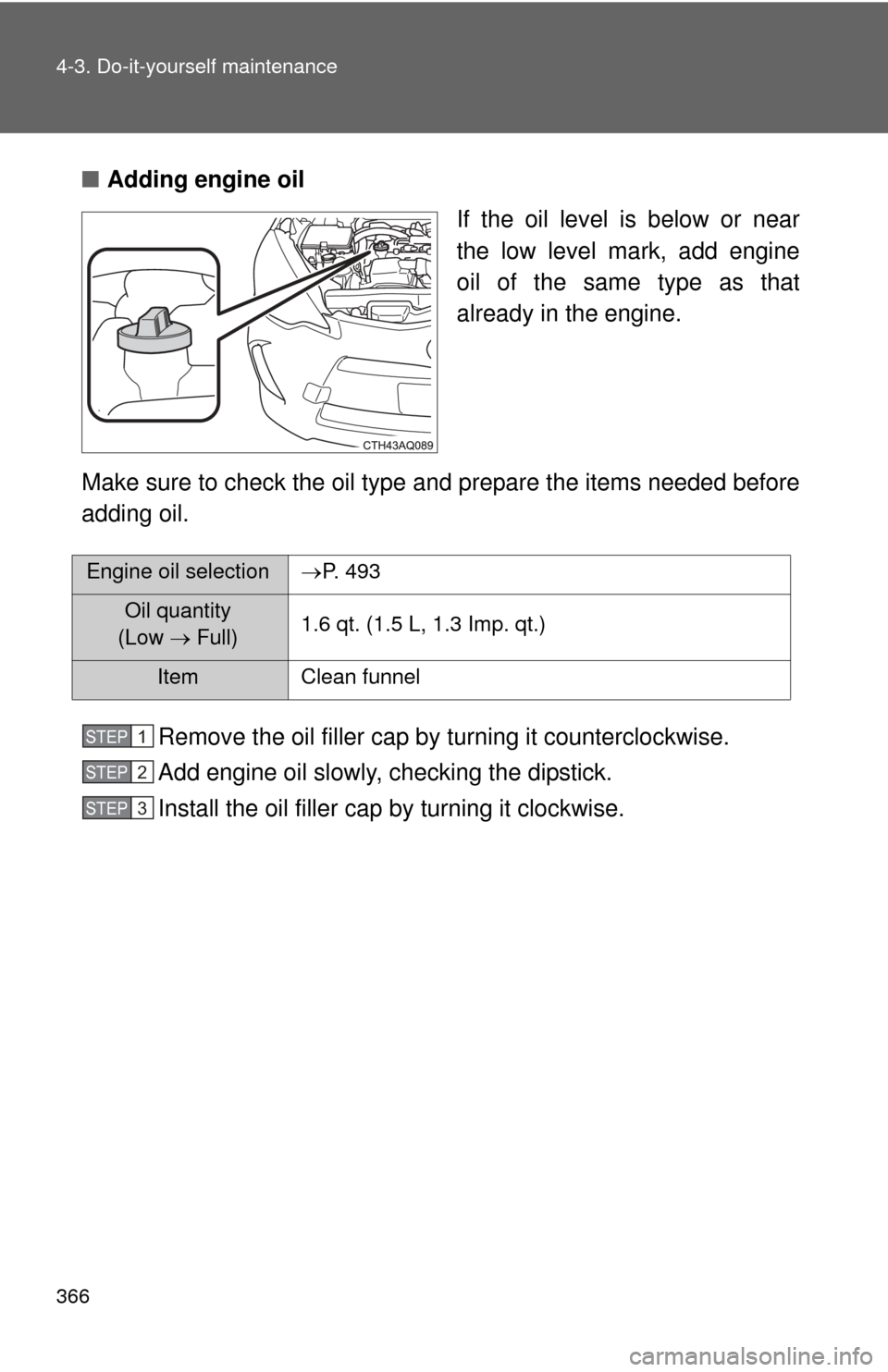
366 4-3. Do-it-yourself maintenance
■Adding engine oil
If the oil level is below or near
the low level mark, add engine
oil of the same type as that
already in the engine.
Make sure to check the oil type and prepare the items needed before
adding oil.
Remove the oil filler cap by turning it counterclockwise.
Add engine oil slowly, checking the dipstick.
Install the oil filler cap by turning it clockwise.
Engine oil selection P. 493
Oil quantity
(Low Full) 1.6 qt. (1.5 L, 1.3 Imp. qt.)
Item Clean funnel
STEP1
STEP2
STEP3
Page 400 of 552
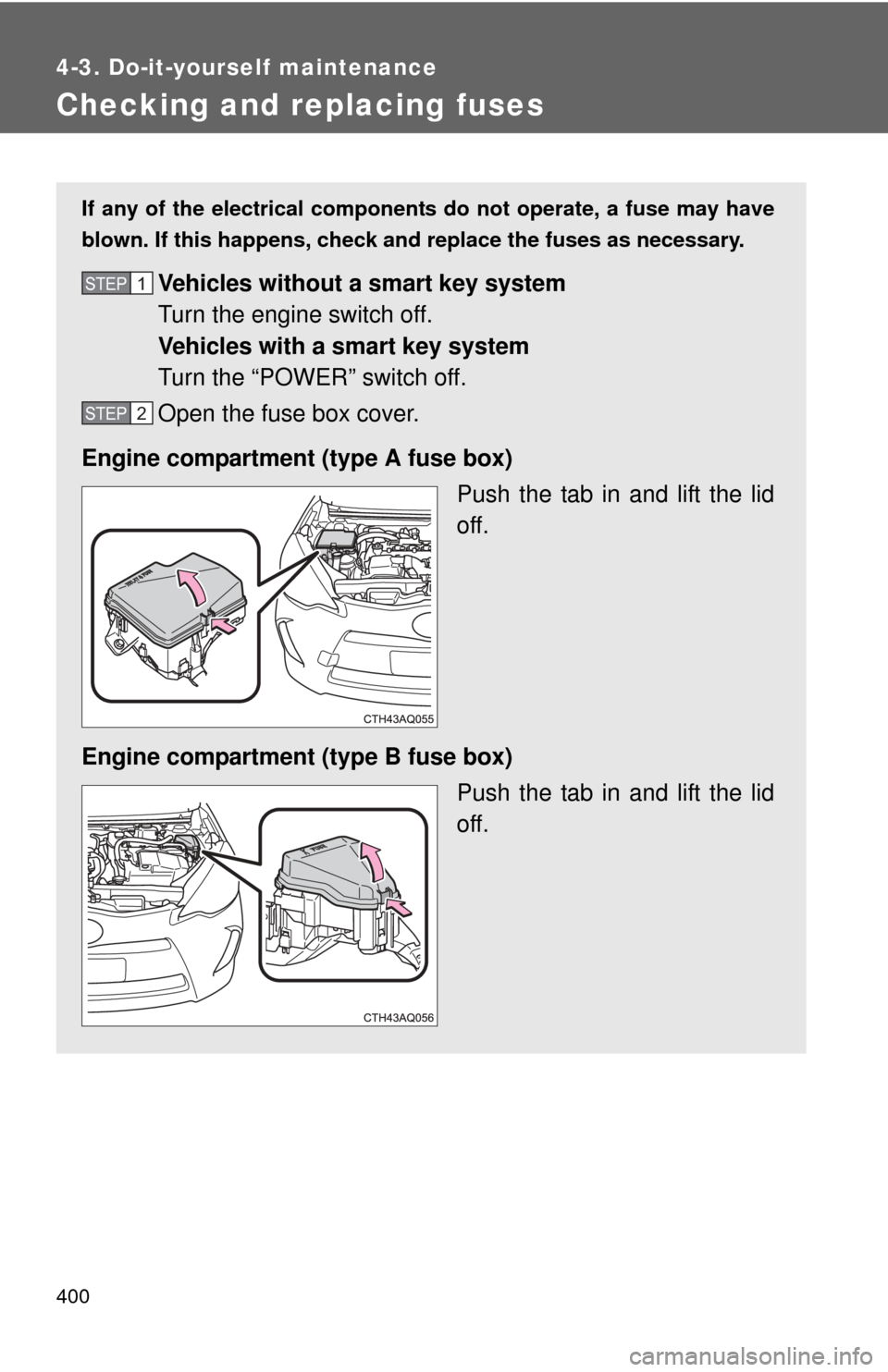
400
4-3. Do-it-yourself maintenance
Checking and replacing fuses
If any of the electrical components do not operate, a fuse may have
blown. If this happens, check and replace the fuses as necessary.
Vehicles without a smart key system
Turn the engine switch off.
Vehicles with a smart key system
Turn the “POWER” switch off.
Open the fuse box cover.
Engine compartment (type A fuse box) Push the tab in and lift the lid
off.
Engine compartment (type B fuse box) Push the tab in and lift the lid
off.STEP1
STEP2
Page 404 of 552
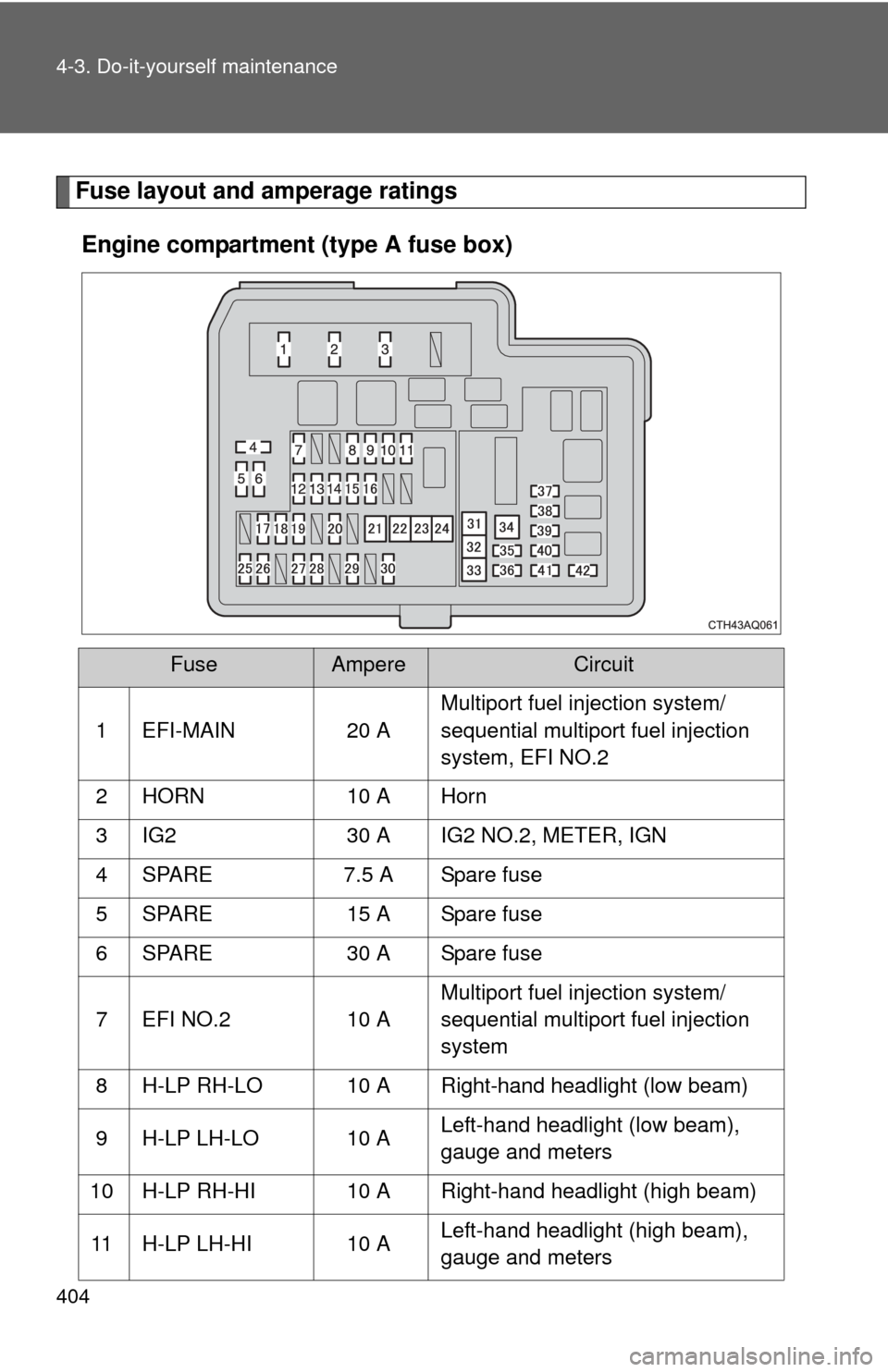
404 4-3. Do-it-yourself maintenance
Fuse layout and amperage ratingsEngine compartment (type A fuse box)
FuseAmpereCircuit
1 EFI-MAIN 20 A Multiport fuel injection system/
sequential multiport fuel injection
system, EFI NO.2
2 HORN 10 A Horn
3 IG2 30 A IG2 NO.2, METER, IGN
4 SPARE 7.5 A Spare fuse
5 SPARE 15 A Spare fuse
6 SPARE 30 A Spare fuse
7 EFI NO.2 10 A Multiport fuel injection system/
sequential multiport fuel injection
system
8 H-LP RH-LO 10 A Right-hand headlight (low beam)
9 H-LP LH-LO 10 A Left-hand headlight (low beam),
gauge and meters
10 H-LP RH-HI 10 A Right-hand headlight (high beam)
11 H-LP LH-HI 10 A Left-hand headlight (high beam),
gauge and meters
Page 407 of 552
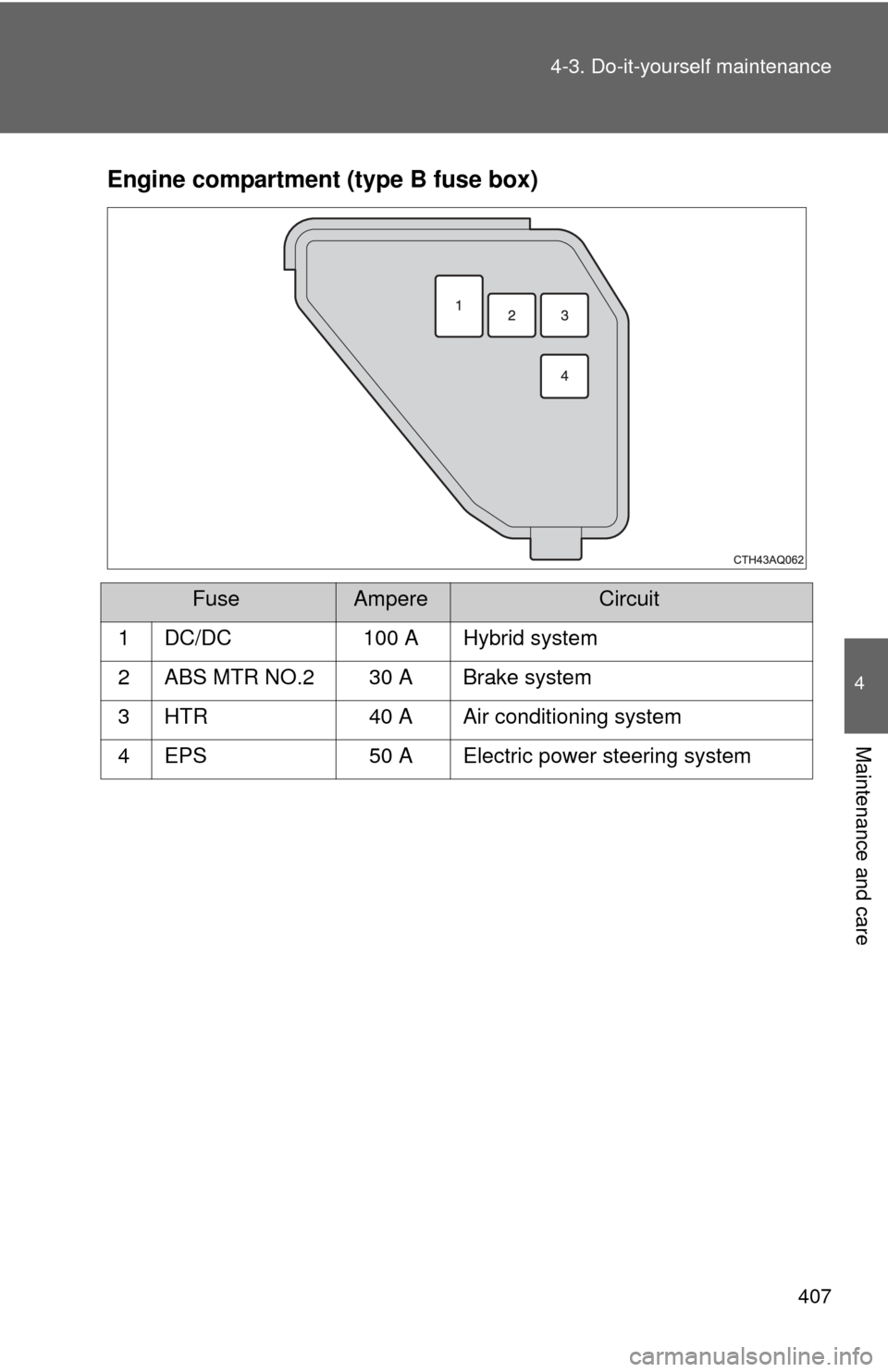
407
4-3. Do-it-yourself maintenance
4
Maintenance and care
Engine compartment (type B fuse box)
FuseAmpereCircuit
1 DC/DC 100 A Hybrid system
2 ABS MTR NO.2 30 A Brake system
3 HTR 40 A Air conditioning system
4 EPS 50 A Electric power steering system
Page 429 of 552
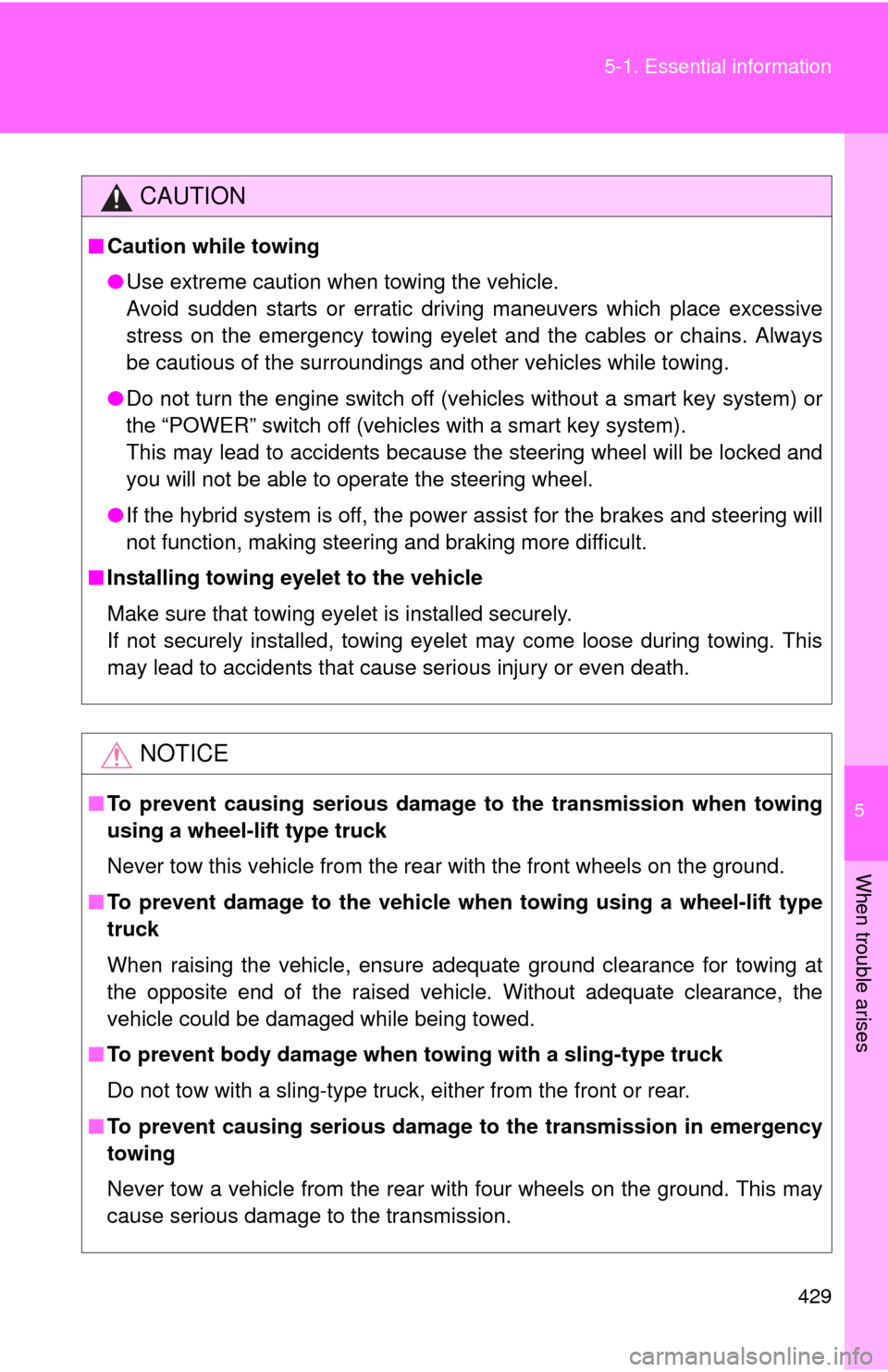
5
When trouble arises
429
5-1. Essential information
CAUTION
■
Caution while towing
●Use extreme caution when towing the vehicle.
Avoid sudden starts or erratic driving maneuvers which place excessive
stress on the emergency towing eyelet and the cables or chains. Always
be cautious of the surroundings and other vehicles while towing.
● Do not turn the engine switch off (vehicles without a smart key system) or
the “POWER” switch off (vehicles with a smart key system).
This may lead to accidents because the steering wheel will be locked and
you will not be able to operate the steering wheel.
● If the hybrid system is off, the power assist for the brakes and steering will
not function, making steering and braking more difficult.
■ Installing towing eyelet to the vehicle
Make sure that towing eyelet is installed securely.
If not securely installed, towing eyelet may come loose during towing. This
may lead to accidents that cause serious injury or even death.
NOTICE
■To prevent causing serious damage to the transmission when towing
using a wheel-lift type truck
Never tow this vehicle from the rear with the front wheels on the ground.
■ To prevent damage to the vehicle when towing using a wheel-lift type
truck
When raising the vehicle, ensure adequate ground clearance for towing at
the opposite end of the raised vehicle. Without adequate clearance, the
vehicle could be damaged while being towed.
■ To prevent body damage when towing with a sling-type truck
Do not tow with a sling-type truck, either from the front or rear.
■ To prevent causing serious damage to the transmission in emergency
towing
Never tow a vehicle from the rear with four wheels on the ground. This may
cause serious damage to the transmission.
Page 437 of 552
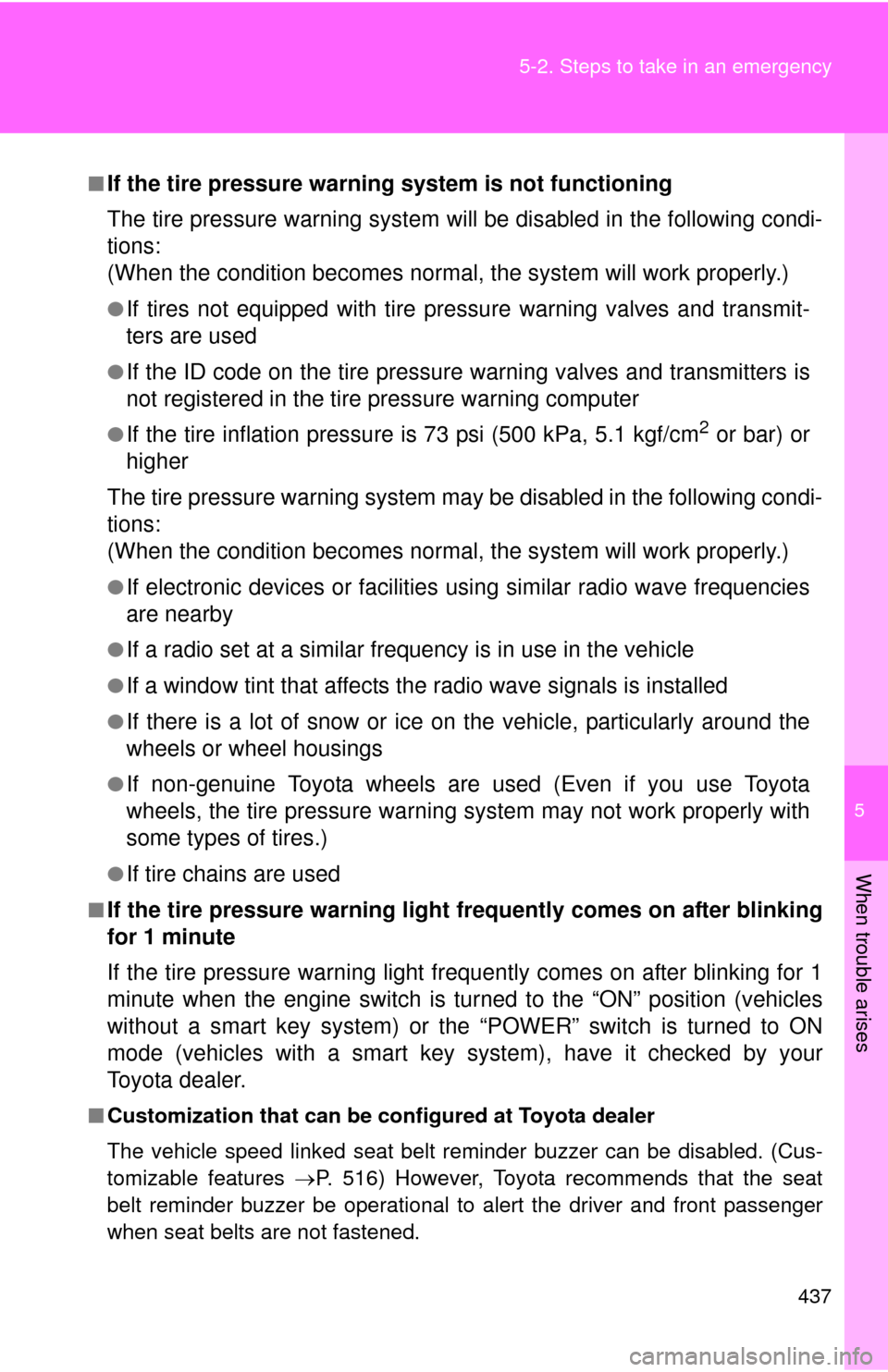
5
When trouble arises
437
5-2. Steps to take in an emergency
■If the tire pressure warning system is not functioning
The tire pressure warning system will be disabled in the following condi-
tions:
(When the condition be
comes normal, the system will work properly.)
●If tires not equipped with tire pressure warning valves and transmit-
ters are used
●If the ID code on the tire pressure warning valves and transmitters is
not registered in the tire pressure warning computer
●If the tire inflation pressure is 73 psi (500 kPa, 5.1 kgf/cm2 or bar) or
higher
The tire pressure warning system may be disabled in the following condi-
tions:
(When the condition be comes normal, the system will work properly.)
●If electronic devices or facilities using similar radio wave frequencies
are nearby
●If a radio set at a similar frequency is in use in the vehicle
●If a window tint that affects the radio wave signals is installed
●If there is a lot of snow or ice on the vehicle, particularly around the
wheels or wheel housings
●If non-genuine Toyota wheels are used (Even if you use Toyota
wheels, the tire pressure warning system may not work properly with
some types of tires.)
●If tire chains are used
■If the tire pressure warning light frequently comes on after blinking
for 1 minute
If the tire pressure warning light frequently comes on after blinking for 1
minute when the engine switch is tu rned to the “ON” position (vehicles
without a smart key system) or the “POWER” switch is turned to ON
mode (vehicles with a smart key syst em), have it checked by your
Toyota dealer.
■ Customization that can be co nfigured at Toyota dealer
The vehicle speed linked seat belt reminder buzzer can be disabled. (Cus-
tomizable features P. 516) However, Toyota recommends that the seat
belt reminder buzzer be operational to alert the driver and front passenger
when seat belts are not fastened.
Page 492 of 552
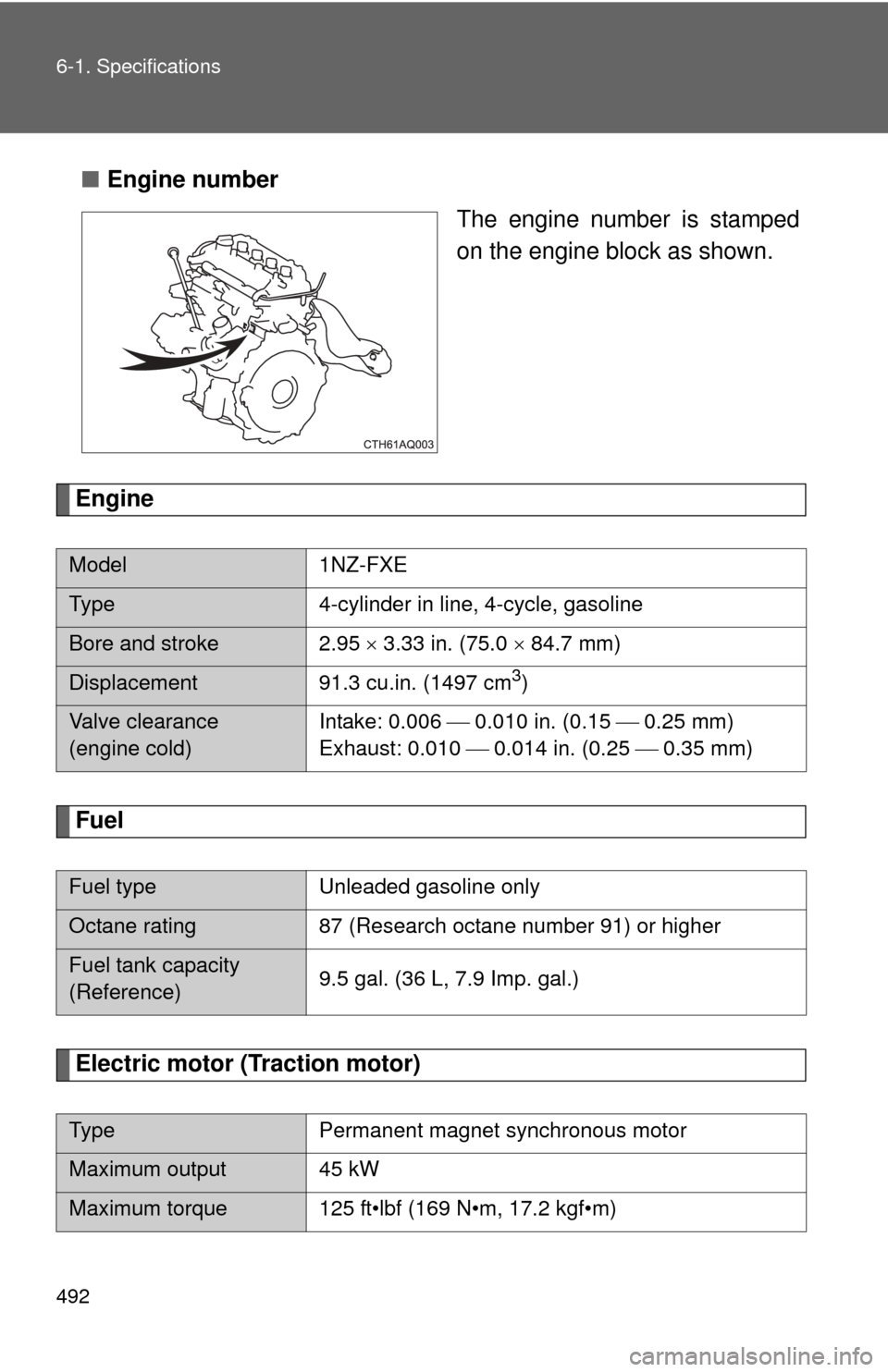
492 6-1. Specifications
■Engine number
The engine number is stamped
on the engine block as shown.
Engine
Fuel
Electric motor (Traction motor)
Model1NZ-FXE
Type 4-cylinder in line, 4-cycle, gasoline
Bore and stroke 2.95 3.33 in. (75.0 84.7 mm)
Displacement 91.3 cu.in. (1497 cm3)
Valve clearance
(engine cold) Intake: 0.006 0.010 in. (0.15 0.25 mm)
Exhaust: 0.010 0.014 in. (0.25 0.35 mm)
Fuel type Unleaded gasoline only
Octane rating 87 (Research octane number 91) or higher
Fuel tank capacity
(Reference) 9.5 gal. (36 L, 7.9 Imp. gal.)
Type
Permanent magnet synchronous motor
Maximum output 45 kW
Maximum torque 125 ft•lbf (169 N•m, 17.2 kgf•m)